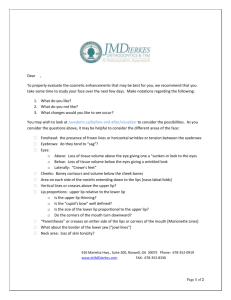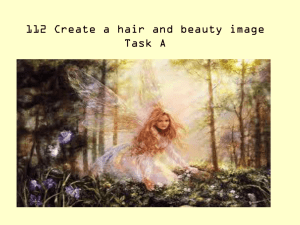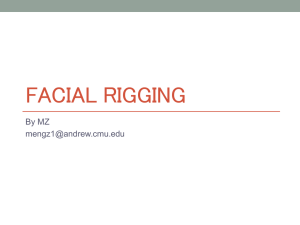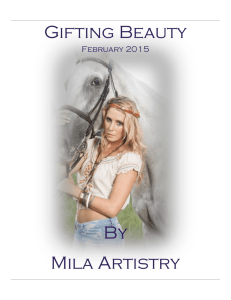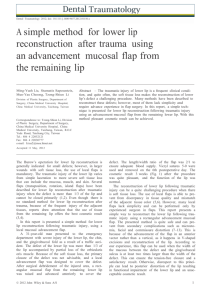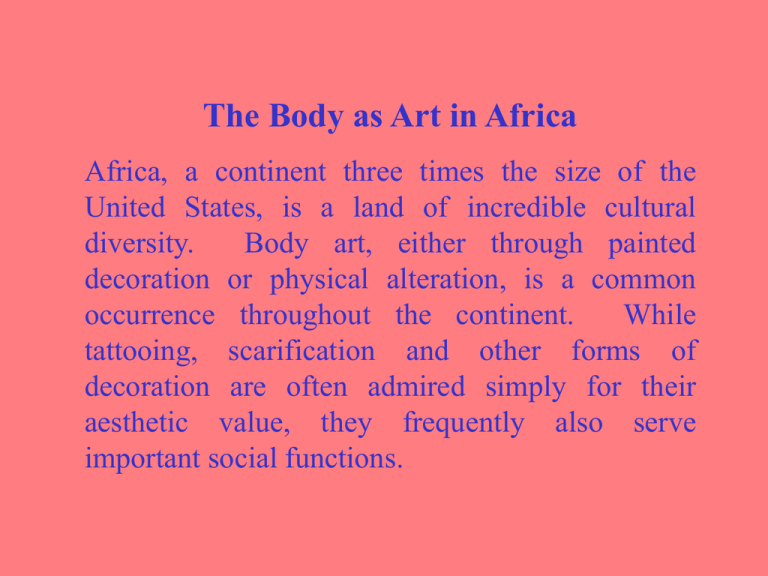
The Body as Art in Africa
Africa, a continent three times the size of the
United States, is a land of incredible cultural
diversity.
Body art, either through painted
decoration or physical alteration, is a common
occurrence throughout the continent.
While
tattooing, scarification and other forms of
decoration are often admired simply for their
aesthetic value, they frequently also serve
important social functions.
A young Maasai girl
from Kenya wears an
elaborate outfit made
out of beads.
Beaded decorations
are the most
common ornaments
worn by Maasai men
and women.
Surma men paint their
bodies in preparation
for donga stick fights
in order to emphasize
their physical beauty
and to intimidate their
adversaries
No part of their
bodies goes
undecorated.
Hamar girls wear
their hair in tightly
rolled balls…
…while Hamar women
wear their hair in long
rolled strands
Similarly, A Hopi girl
wears her hair in a
“butterfly” pattern until
she gets married, after
which she wears it
straight.
Among the Karo peoples,
yellow and white paint
transform the body,
releasing the spirit of the
Karo. The clay hair buns
and ostrich feathers signify
that a man has killed and
enemy.
An acknowledged killer
receives livestock, sexual
favors and is allowed to
wear special jewelry that
signify his status.
He is also much more
likely to be desired by
a women and to be
seen as a suitable sonin-law by her family.
A Muslim Afar female wears
the finest and most exotic
jewelry available during
marriages and other
celebrations. Some of it is
made locally, while some is
brought by relatives
returning from overseas
Despite the Islamic code
of modesty, this Swahili
woman, holding her child,
reveals elaborate henna
decorations on her hand.
Scarification for many
African peoples,
including this Mursi man,
is considered a sign of
beauty, a means of
attracting the opposite
sex.
Karo women scarify
their chests to
enhance their
beauty. They
believe that the skin
texture of a scarified
woman holds a
sensual appeal for
men.
The complete
scarification of a
Karo man’s chest
indicates that he
has killed an
enemy or a
dangerous animal.
Tattoos are also common throughout Africa.
However, while tattoos are thought to enhance
one’s beauty, they also often have the purpose of
displaying one’s ethnic and lineage identity, as
illustrated by this young Fulani girl.
The parallel lines
of scarification
identify this man
as a Nuer.
Facial
scarification
identifies this
woman as an
Afar.
Ears plugs are
worn by the
Surma women for
decoration.
Lip plates are also
worn by Surma
women.
*
*
*
It takes about six
months to stretch
the lip to
accommodate a fullsized lip plate.
The final size of the lip
plate indicates the
number of cattle paid as
brideprice.
Since the size of the lip
plate indicates the number
of cattle given in marriage,
it visibly communicates a
woman’s social status.
Tattooing and body mutilation are not exactly
unknown in the U.S.
Body Ritual among the Nacirema
Body piercing represents
an identity statement in
the U. S.
Before
After
. . . as do breast enlargements . . .
. . . even though
breast enlargements
involve the insertion
of a foreign object
into the body.
Silicon Implant
Liposuction is widely used to alter other parts of the body.
Women are not
the only ones to
alter their
physical
appearance in
order to enhance
their social
status . . .
. . . Many men
also alter their
appearance in
order to enhance
their social
status.
Transvestism is also important
to the identity of many gay men.
Botoxing has also
become very popular . . .
. . . in order to eliminate
“unsightly” wrinkles.
Here is a REAL personal identity statement.
Even some Muhlenberg
faculty have been
known to decorate
themselves in strange
garb.
. . . especially when the heat of the sun
has fried their brain.


